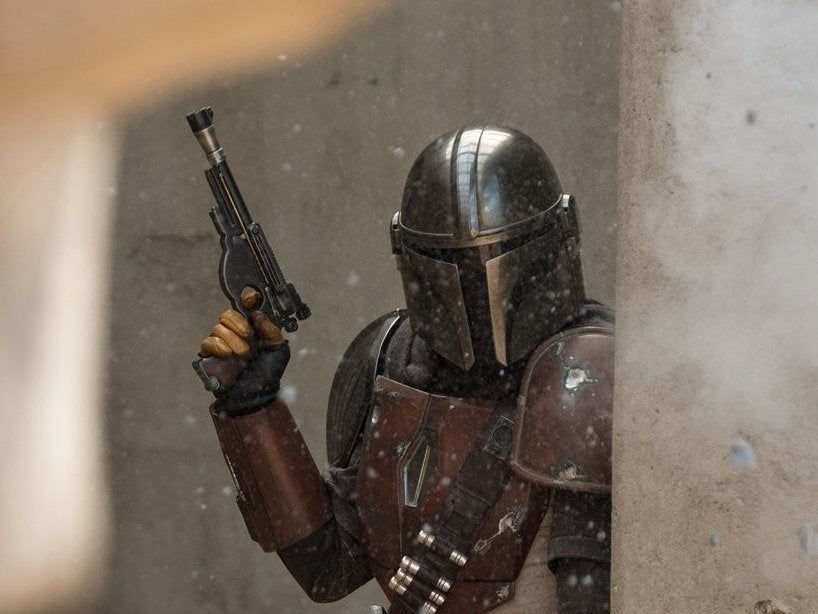Disney+: It's better for all of us that Disney’s rival service to Netflix faces an uphill battle
With its Marvel, Pixar and Star Wars catalogue, Disney+ intends to take the king of the streamers crown from Netflix, but Amazon is also catching up fast, and it’s in viewers’ interests for the competition to be fierce, says Clarisse Loughrey


Your support helps us to tell the story
From reproductive rights to climate change to Big Tech, The Independent is on the ground when the story is developing. Whether it's investigating the financials of Elon Musk's pro-Trump PAC or producing our latest documentary, 'The A Word', which shines a light on the American women fighting for reproductive rights, we know how important it is to parse out the facts from the messaging.
At such a critical moment in US history, we need reporters on the ground. Your donation allows us to keep sending journalists to speak to both sides of the story.
The Independent is trusted by Americans across the entire political spectrum. And unlike many other quality news outlets, we choose not to lock Americans out of our reporting and analysis with paywalls. We believe quality journalism should be available to everyone, paid for by those who can afford it.
Your support makes all the difference.Disney+ is set to enter the streaming wars like a wrecking ball. At least, that’s what it wants you to think. The service, set to debut in the US on 12 November, has been billed as a one-stop-shop for all of the studio’s existing content – from Marvel to Star Wars, National Geographic to Frozen. Add to that a whole host of new films and TV shows, boasting A-list stars and blockbuster-sized budgets. There’s zero subtlety about this. Disney+ has no ambitions to start small and grow steadily in size. It’s here to conquer. Yet there’s been a lot of big talk for a service that still has much to prove, especially when it comes to challenging the current king of the streamers, Netflix, and its base of over 150 million subscribers worldwide (and growing). It’ll also have to fend off the likes of Amazon Prime, alongside several yet-to-debut services from Disney’s biggest competitors at the box office – Universal and Warner Bros.
The boldest of Disney+’s strategies here is its pricing. Crucially, there’s been no official announcement of when the service will become available in the UK, due to several existing agreements that allow Sky to air the studio’s properties. In the US, however, subscriptions will cost just $6.99 (£5.70) a month, with access to four simultaneous streams, alongside 4K and Ultra HD picture quality. Those are options you’d normally only get by signing up to Netflix’s premium plan, which costs $15.99 per month, while its basic package is still $12.99 per month – the exact same price as the Disney+ bundle that includes Hulu and ESPN+, both owned by the studio.
It’s not just a bit of aggressive marketing, though. Disney CEO Robert Iger has been very upfront about the fact that the Disney+ library will initially be much smaller than its competitors. In the first year of launch, the service will feature 500 films and 7,500 episodes of TV, in comparison to Netflix’s estimated 4,000 films and 47,000 episodes (according to Ampere Analysis). That number will surely only grow and, for now, the studio can offer such cut-throat prices because it doesn’t have to worry about expensive licensing deals. Netflix, meanwhile, is in a very different boat. Its library is about to take some major hits now that Disney, Universal, and Warner Bros are starting to pull their product in order to place it on their own streaming services.
Will Netflix have the same appeal when it’s no longer the place to binge endless episodes of The Office and Friends? It’s hard to tell. The service has been so reluctant to release any kind of viewing data that it’s almost impossible to figure out how successful its original content is in comparison to what it licenses from other companies. A handful of shows have managed to enter the cultural mainstream, certainly, and even won a few awards along the way, including Stranger Things, Orange is the New Black, and Making a Murderer. In more recent months, Netflix appears to have narrowed its focus and started snatching up more experienced talent, landing deals with Game of Thrones creators David Benioff and DB Weiss, Patty Jenkins, Scandal’s Shonda Rhimes, and Ryan Murphy.
It’s a similar approach to how Netflix releases its films, where there’s been a focus on handing over creative control to filmmakers with a certain cultural capital and seeing what they cook up. It’s helped a number of them realise their dream projects. And, for every misstep (think Bright or Duncan Jones’s Mute), there’s something like Roma, Alfonso Cuarón’s personal masterpiece and the winner of three Academy Awards. Next month, we’ll finally get to see The Irishman, Martin Scorsese’s long-gestating project starring Robert De Niro, Al Pacino and Joe Pesci.
Disney can’t realistically function this way. At least, it can’t outside of its smaller, more independent offshoots (formerly Miramax and now, presumably, Fox Searchlight). It’s simply not in its DNA, since the entire company bases itself around a single, cohesive vision that can be traced all the way back to Walt Disney himself. Its streaming service, then, is destined to play heavily into the familiar. In the first year after launch, you’ll be able to watch every Star Wars and Pixar film in existence, alongside 5,000 episodes of Disney Channel and Disney Jr shows. They’ll be nicely accompanied by new releases, including a Monsters Inc series and a Lizzie McGuire revival (featuring the triumphant return of Hilary Duff).
At the centre of it all is The Mandalorian, the jewel in Disney+’s crown and the very first live-action Star Wars series. With December’s The Rise of Skywalker bringing the latest trilogy to an end, and with nothing else locked in the release schedule, Lucasfilm is now looking towards television for its future. It gives the films a little breathing room, at least, if you’re inclined to believe that Solo: A Star Wars Story’s mediocre box office returns were the result of oversaturation. Set five years after Return of the Jedi, The Mandalorian stars Pedro Pascal as a bounty hunter navigating the outer reaches of the galaxy, home to the last gasps of a defeated empire. The trailers have so far lived up to Kathleen Kennedy’s promise that the show would maintain the same quality as the films. It’s gorgeous-looking, with echoes of the grittier aesthetics of 2016’s Rogue One and plenty of nods to the samurai films and westerns that inspired it. The Mandalorian will be followed up by a series based on Rogue One characters Cassian Andor and K-2SO, with Ewan McGregor then stepping back into Obi-Wan Kenobi’s shoes for his own spin-off.
Marvel is also making a big splash on the service, with shows such as Loki, The Falcon and the Winter Soldier, and Hawkeye. An obvious tactic here is that Disney+ is trying to guarantee subscribers by teasing that certain characters introduced in its shows (namely Kamala Khan, who will get her own Ms Marvel series) will later appear in the films. Hand over your hard-earned dollars or risk getting Fomo, Marvel fans. What’s most intriguing, however, is how risky some of these projects seem to be. Take What If…?, an animated series based around alternate timelines, including one where Hayley Atwell’s Peggy Carter gets injected with Captain America’s supersoldier serum and starts wielding a Union Jack-emblazoned shield. Or what about WandaVision, which traps Elizabeth Olsen’s Scarlet Witch and Paul Bettany’s Vision in a 1950s sitcom?
Much like Netflix, Disney+ will almost certainly be keeping its viewing numbers tightly under wraps. Which, for them, might actually be a good thing, since they’ll be less obsessively fixated on every release becoming a record-breaking hit. For example, it’s given them the room to essentially resurrect the kind of mid-budget family fare that’s been near impossible to make in the blockbuster age. Although Lady and the Tramp, on the surface, is just the latest in the studio’s long line of live-action remakes, its use of real dogs – made to talk with a little CGI magic – feels reminiscent of the animal flicks that reigned supreme in the Nineties, including Homeward Bound and Babe. Add to that Togo, a film about a scrappy sled dog that, for some reason, stars Willem Dafoe. There’s also some traditional Christmas fare in the form of Noelle, which sees Anna Kendrick play a member of the North Pole’s own Kringle family, who heads off on the search for her missing brother, recently promoted as the new Santa Claus.

Watch Apple TV+ free for 7 days
New subscribers only. £8.99/mo. after free trial. Plan auto-renews until cancelled

Watch Apple TV+ free for 7 days
New subscribers only. £8.99/mo. after free trial. Plan auto-renews until cancelled
Yet the service is always going to be severely limited in what it can provide, since it’s perpetually stuck inside the Disney mould. Disney+ will be a strictly family-friendly platform, with reports suggesting that Hulu will be developed in tandem as the home of more mature fare. Presumably, this is where some of the more valuable content that Disney acquired in the Fox merger will sit, although the studio’s stayed very quiet on how it’ll be handling franchises such as Alien. Even then, it’s lacking the range Netflix can provide: they’ve got their indie darlings and award winners, but they’re also providing an absolute bounty of binge-ready nonsense, from property shows to low-budget horrors. It’s the stuff we never like to admit that we watch, but still crave on occasion. Disney+ will have a small selection of reality programming, including Be Our Chef, a cooking competition, and Pixar in Real Life, a prank show. But it’s all so achingly on-brand for Disney that it’s hardly going to hit the same impulses as all of Netflix’s glorious trash.
In short, Disney+’s dominance isn’t guaranteed. Its flashy line-up of properties is bound to attract big numbers at first but, in the long run, how well will it actually integrate into the average TV viewer’s lifestyle? Does it have everything we could ever want from a streaming service? In truth, it’s in everyone’s best interests that Disney+ faces a bit of an uphill battle and, maybe, even takes a few hits. Unchecked growth has been a major concern across many US industries, and the fact that Disney was behind five of this year’s six highest-grossing films simply isn’t healthy for the state of the industry. There’s nothing compelling the studio to try anything new. The streaming world, however, is a younger, less-established market where the rules of success haven’t quite been laid out yet. Netflix may be king for now, but its future isn’t so secure – with more than 100 million subscribers, Amazon Prime is catching up fast. It’s exactly as it should be. Competition is what breeds smart risks and bright ideas, as companies attempt to outmatch each other and grab our attention. And Disney could do with a little competition right now.
Join our commenting forum
Join thought-provoking conversations, follow other Independent readers and see their replies
Comments